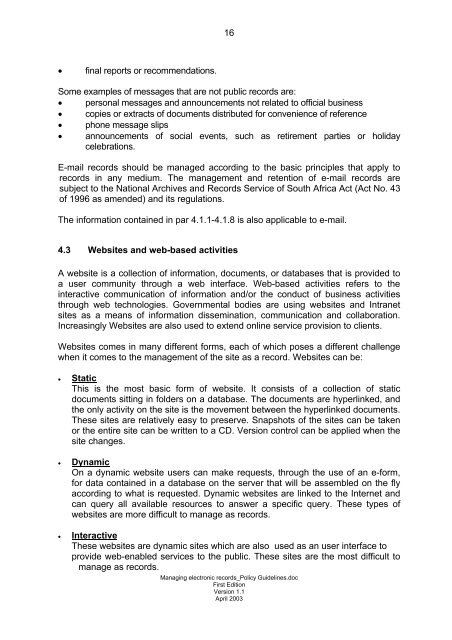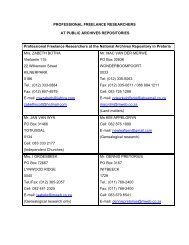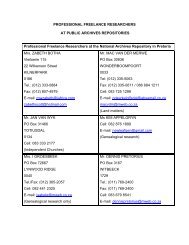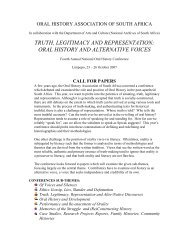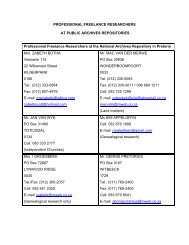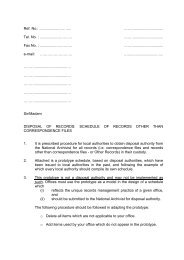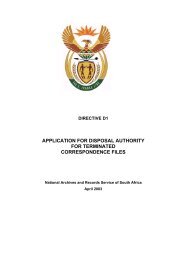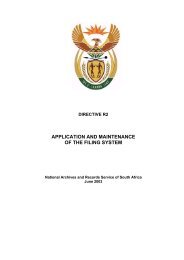managing electronic records in governmental bodies - National ...
managing electronic records in governmental bodies - National ...
managing electronic records in governmental bodies - National ...
Create successful ePaper yourself
Turn your PDF publications into a flip-book with our unique Google optimized e-Paper software.
16<br />
• f<strong>in</strong>al reports or recommendations.<br />
Some examples of messages that are not public <strong>records</strong> are:<br />
• personal messages and announcements not related to official bus<strong>in</strong>ess<br />
• copies or extracts of documents distributed for convenience of reference<br />
• phone message slips<br />
• announcements of social events, such as retirement parties or holiday<br />
celebrations.<br />
E-mail <strong>records</strong> should be managed accord<strong>in</strong>g to the basic pr<strong>in</strong>ciples that apply to<br />
<strong>records</strong> <strong>in</strong> any medium. The management and retention of e-mail <strong>records</strong> are<br />
subject to the <strong>National</strong> Archives and Records Service of South Africa Act (Act No. 43<br />
of 1996 as amended) and its regulations.<br />
The <strong>in</strong>formation conta<strong>in</strong>ed <strong>in</strong> par 4.1.1-4.1.8 is also applicable to e-mail.<br />
4.3 Websites and web-based activities<br />
A website is a collection of <strong>in</strong>formation, documents, or databases that is provided to<br />
a user community through a web <strong>in</strong>terface. Web-based activities refers to the<br />
<strong>in</strong>teractive communication of <strong>in</strong>formation and/or the conduct of bus<strong>in</strong>ess activities<br />
through web technologies. Governmental <strong>bodies</strong> are us<strong>in</strong>g websites and Intranet<br />
sites as a means of <strong>in</strong>formation dissem<strong>in</strong>ation, communication and collaboration.<br />
Increas<strong>in</strong>gly Websites are also used to extend onl<strong>in</strong>e service provision to clients.<br />
Websites comes <strong>in</strong> many different forms, each of which poses a different challenge<br />
when it comes to the management of the site as a record. Websites can be:<br />
• Static<br />
This is the most basic form of website. It consists of a collection of static<br />
documents sitt<strong>in</strong>g <strong>in</strong> folders on a database. The documents are hyperl<strong>in</strong>ked, and<br />
the only activity on the site is the movement between the hyperl<strong>in</strong>ked documents.<br />
These sites are relatively easy to preserve. Snapshots of the sites can be taken<br />
or the entire site can be written to a CD. Version control can be applied when the<br />
site changes.<br />
• Dynamic<br />
On a dynamic website users can make requests, through the use of an e-form,<br />
for data conta<strong>in</strong>ed <strong>in</strong> a database on the server that will be assembled on the fly<br />
accord<strong>in</strong>g to what is requested. Dynamic websites are l<strong>in</strong>ked to the Internet and<br />
can query all available resources to answer a specific query. These types of<br />
websites are more difficult to manage as <strong>records</strong>.<br />
• Interactive<br />
These websites are dynamic sites which are also used as an user <strong>in</strong>terface to<br />
provide web-enabled services to the public. These sites are the most difficult to<br />
manage as <strong>records</strong>.<br />
Manag<strong>in</strong>g <strong>electronic</strong> <strong>records</strong>_Policy Guidel<strong>in</strong>es.doc<br />
First Edition<br />
Version 1.1<br />
April 2003


